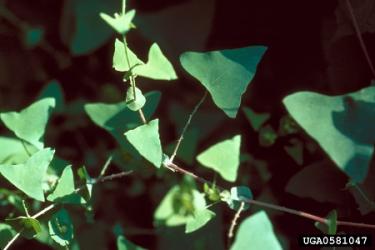When You Have a Mile-a-Minute Infestation
Mile-a-minute weed is a tough adversary, but it isn’t impossible to control. There are several approaches you can take, depending on the size of your infestation.
Mechanical control (pulling). For small infestations, pulling the mile-a-minute by hand or with a machine is a good option, because the weed has a relatively weak root system. If you’re hand-pulling, it’s best to do so before the recurved barbs on the stems and leaves harden; you’ll need thick gloves to pull them afterwards. You can also use repeated mowing or weed whipping to destroy the vines or reduce their flowering and seed production.
Herbicides. Most widely used herbicides will work on mile-a-minute. But because the vine grows over other vegetation, it can be difficult to selectively control the vine itself without collateral damage. If you have an extensive infestation, one option is to use a pre-emergence herbicide (an herbicide that keeps the seeds from germinating in the first place) in early spring, and then follow up with a post-emergence herbicide application to the plants that survived and germinated anyway. The post-emergence herbicides (Garlon 3A) and glyphosate (Glyphomate 41) are very good choices, as they won’t sterilize or otherwise damage your soil and they’re less likely to harm other organisms.
Biological control. In 1996, the U.S. Forest Service began a study of insects that feed on and damage mile-a-minute in hopes of finding a biological control for the weed. They identified a small weevil, Rhinoncomimus latipes Korotyaev, that feeds on the vine’s foliage and produces larvae that bore into the vine’s stems and nodes. The weevils were released in test sites in several northeastern states, and were found to reduce mile-a-minute densities to only 25 percent or less of what they had been at the start, within just 2-3 years. About 150,000 weevils were released in five states from 2005 through 2009, and they continue to be studied today.
Mile-a-minute seeds can remain viable in your soil for as long as 6 years, so whichever method you choose to control your infestation, it will take repeated applications to eradicate the weed entirely. Your patience and persistence will pay off, though—and they can go a long way towards preventing an infestation as well.
How can I get more tips?
It’s simple! Enter your email below.

